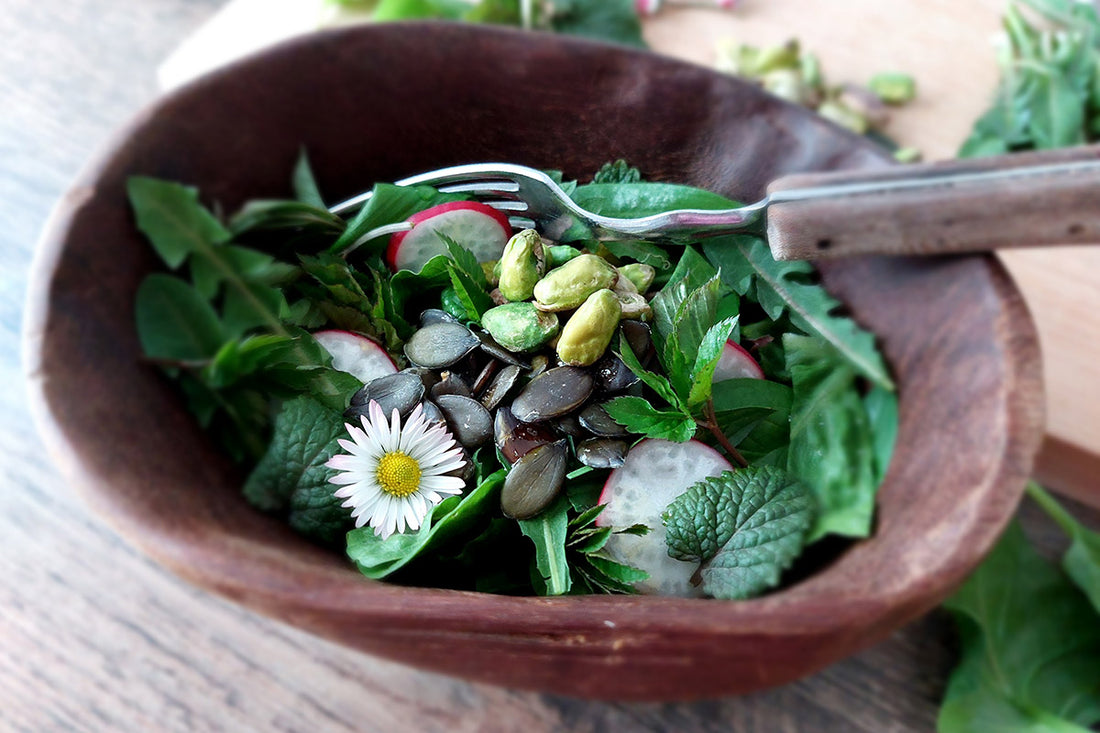
Spring salad with wild herbs and activated pumpkin seeds and pistachios
Share
It's early spring! We feel it with every fiber. Nature is awakening, the days are getting noticeably longer, everywhere it begins to green and sprout. For our ancestors, this first green of spring was essential for survival after the long, deprived winters. The first fresh leaves in spring are particularly tender and at the same time contain a lot of vitamins and important nutrients.
Nowadays, winters are no longer really a time of privation for us. We have the whole range of food available to us year in, year out. On the one hand, this is nice because we never have to suffer shortages. On the other hand, we may have lost our sense of what is particularly good for us at any given moment. The first green of spring can still give us an unbelievable energy boost, if we just let ourselves go for it.
Therefore, I would like to take you today into the world of wild herbs and activated nuts. We will prepare a spring salad that really has it all. If you enjoy this salad consciously, you will feel how much energy the herbs and activated nuts can give you.
Activated pistachios - why are they so healthy?
Pistachios - just like almonds - are not nuts at all, but the seeds of a stone fruit. They are incredibly healthy and provide you with a whole range of valuable ingredients. Among the minerals, potassium is the most important: 100 g of pistachios contain almost three times more potassium than 100 g of bananas, which are usually considered the potassium supplier par excellence. In addition, pistachios provide you with a whopping 18% vegetable protein, and about 10% fiber. The latter support your intestinal flora and can even help you lose weight. A high proportion of antioxidants and vitamin E has an anti-inflammatory effect, protects your cells and can even prevent various cancers. The unsaturated fatty acids found in pistachios protect your blood vessels and heart. By the way, the greener the pistachio, the higher the quality.
Activated pumpkin seeds - what makes them so valuable?
Pumpkin seeds are also not nuts, but - as the name suggests - the seeds of the pumpkin plant. In principle, the seeds of all edible pumpkins are edible. However, the dark green seeds of the oil pumpkin are particularly well-known and popular. The spectrum of ingredients is quite similar to that of pistachios, which is why I chose these two seeds for our spring salad. Pumpkin seeds also contain many antioxidants that protect against inflammation and some cancers. Especially in spring, they support our immune system quite wonderfully. Pumpkin seeds provide you with a lot of magnesium, which you can use if you want to exercise more in spring. The unsaturated fatty acids they contain are good for cholesterol levels and the cardiovascular system.
Why activated pistachios and pumpkin seeds
When we activate our pistachios and pumpkin seeds in Mooseurach, we only use raw kernels. This means that when they reach us, they have never been exposed to high temperatures. All their valuable ingredients are preserved. And it stays that way when we activate them. We soak our nuts and kernels in finely tuned spring water-sea salt mixtures and then dry them slowly and gently(blog article "2die4 activation process"). During this process, they expose all their healthy ingredients so that your body can utilize them to the maximum. Much better than if you just eat them raw. Especially now in spring, activated nuts give you a wonderful energy boost.
What's green? Get to know the wild herbs for your spring salad!
Many of our native wild herbs are edible and non-toxic. Still, it's very important to know exactly what you're putting in your salad. That's why I've picked out a few plants for you that are easy to recognize, and I've also photographed them for you. In general: collect wild herbs only in as untouched places as possible, where no fertilizer is used, where no cars are driving and where no dogs are on the road.
The goutweed
Found almost everywhere in gardens, shady damp woods and shrubbery, it is a thorn in the side of most gardeners. I say eat it rather than eradicate it! From the middle of March, the goutweed stretches its first leaves into the sun. You can recognize it by the three-three-three rule: three times 3 leaves on a stem that is triangular in cross-section. This distinguishes the goutweed from any poisonous relatives. Use only the youngest, barely unfolded, light green leaves. They taste delicately tart, somewhat reminiscent of parsley and give you a lot of vitamin C (4x as much as lemons!). In addition, they have an anti-inflammatory and de-acidifying effect and are therefore also ideally suited to an alkaline diet(blog article "Alkaline diet with activated nuts).
The wild garlic
It is a well-known spice and medicinal plant since time immemorial. It is found in moist, summer-shaded deciduous and riparian forests. All parts of the plant are edible, but it is mainly the young leaves that are eaten raw. These often appear as early as the beginning of March and are clearly recognizable by their characteristic garlic odor. Nevertheless, there is always confusion with the poisonous plants lily of the valley, meadow saffron or arum. If you are not 100% sure that you have wild garlic in your hands, it is better to buy it fresh from the health food store. Its sulfur-containing ingredients give it its typical smell and have antibacterial, digestive and detoxifying effects.
The dandelion
Probably every child loves the striking "dandelions" of the dandelion. Many gardeners hate it because it often spreads en masse. Few know about the great health benefits it gives us(https://de.wikipedia.org/wiki/Gew%C3%B6hnlicher_L%C3%B6wenzahn). The bitter substances it contains have a digestive stimulating effect. In addition, it is said to have liver-protective properties and to have an anti-growth effect on various tumors. The potassium content is high. Both buds and flowers, as well as root and leaves can be used in the kitchen. For our salad, pick only the youngest, most tender leaves.
The ribwort plantain
You can recognize it by its characteristic rosette of narrow, pointed, longitudinally veined leaves. It is found almost everywhere in meadows, along roadsides and in parks and gardens. In herbal medicine, ribwort plantain is used mainly for its antibacterial effect on coughs. The above-ground parts of the plant are also good in the kitchen. You can harvest the first fresh leaves as early as mid-March.
The daisy
The pretty flowers of the daisy look wonderful as decoration on your salad. You can find them already in the beginning of March. But the daisy is not only pretty, but in moderation enjoyed very healthy. With its bitter substances, it stimulates the metabolism and appetite and helps with liver complaints and skin diseases. Never harvest all the flowers of a plant, but only a few at a time. Eaten in very large quantities, daisies can even be mildly toxic.
Lemon balm, mint and co.
If you grow herbs in your garden or on your balcony and overwinter them, you may already be able to harvest the first leaves of lemon balm or mint in mid-March. They are not wild herbs, but they give your salad a wonderful fresh kick.

Preparation of your wild herb salad with activated pistachios and pumpkin seeds
For 2 servings of your spring salad, it's best to gather 2 good handfuls of wild herbs. They don't have to be all the varieties I've shown you. Even just one or two of them are wonderful.
As a base for your wild herb salad, it's best to choose a lettuce that tastes quite mild, such as a mini romaine and a handful of baby spinach. Cut the romaine into strips and wash it thoroughly along with the fresh spinach leaves and wild herbs. Drain the lettuce well and set the daisies aside.
In the meantime, finely slice some radishes. Mix everything and arrange the salad in two pretty bowls, because the eye eats with you. For the dressing, you can keep it simple, because your wild herbs are best used pure. Mix half a teaspoon of sea salt with about 2-3 tablespoons of apple cider vinegar in a small bowl and let the mixture steep briefly. Then pour it over the salad and add a high-quality oil. Olive oil and a dash of pumpkin seed oil are good choices here.
Top each bowl with a tablespoonful of activated pumpkin seeds and pistachios and decorate the salad with a few daisy blossoms.
Enjoy this delightful salad with all your senses! Let spring in and feel how good the herbs and seeds are for you and your body.
| 2DiE4 nuts - discover them here! |

